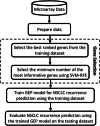Prediction of NSCLC recurrence from microarray data with GEP
- PMID: 28518058
- PMCID: PMC8687152
- DOI: 10.1049/iet-syb.2016.0033
Prediction of NSCLC recurrence from microarray data with GEP
Abstract
Lung cancer is one of the deadliest diseases in the world. Non-small cell lung cancer (NSCLC) is the most common and dangerous type of lung cancer. Despite the fact that NSCLC is preventable and curable for some cases if diagnosed at early stages, the vast majority of patients are diagnosed very late. Furthermore, NSCLC usually recurs sometime after treatment. Therefore, it is of paramount importance to predict NSCLC recurrence, so that specific and suitable treatments can be sought. Nonetheless, conventional methods of predicting cancer recurrence rely solely on histopathology data and predictions are not reliable in many cases. The microarray gene expression (GE) technology provides a promising and reliable way to predict NSCLC recurrence by analysing the GE of sample cells. This study proposes a new model from GE programming to use microarray datasets for NSCLC recurrence prediction. To this end, the authors also propose a hybrid method to rank and select relevant prognostic genes that are related to NSCLC recurrence prediction. The proposed model was evaluated on real NSCLC microarray datasets and compared with other representational models. The results demonstrated the effectiveness of the proposed model.
Figures








Similar articles
-
Lung cancer prediction from microarray data by gene expression programming.IET Syst Biol. 2016 Oct;10(5):168-178. doi: 10.1049/iet-syb.2015.0082. IET Syst Biol. 2016. PMID: 27762231 Free PMC article.
-
Usefulness of Plasma Exosomal MicroRNA-451a as a Noninvasive Biomarker for Early Prediction of Recurrence and Prognosis of Non-Small Cell Lung Cancer.Oncology. 2018;94(5):311-323. doi: 10.1159/000487006. Epub 2018 Mar 13. Oncology. 2018. PMID: 29533963
-
A gene expression signature predicts survival of patients with stage I non-small cell lung cancer.PLoS Med. 2006 Dec;3(12):e467. doi: 10.1371/journal.pmed.0030467. PLoS Med. 2006. PMID: 17194181 Free PMC article.
-
Understanding prognostic gene expression signatures in lung cancer.Clin Lung Cancer. 2009 Sep;10(5):331-40. doi: 10.3816/CLC.2009.n.045. Clin Lung Cancer. 2009. PMID: 19808191 Review.
-
Genomic medicine in non-small cell lung cancer: paving the path to personalized care.Respirology. 2011 Feb;16(2):257-63. doi: 10.1111/j.1440-1843.2010.01892.x. Respirology. 2011. PMID: 21044232 Review.
Cited by
-
Predictive Study on the Occurrence of Wheat Blossom Midges Based on Gene Expression Programming with Support Vector Machines.Insects. 2024 Jun 21;15(7):463. doi: 10.3390/insects15070463. Insects. 2024. PMID: 39057196 Free PMC article.
-
A novel gene selection algorithm for cancer classification using microarray datasets.BMC Med Genomics. 2019 Jan 15;12(1):10. doi: 10.1186/s12920-018-0447-6. BMC Med Genomics. 2019. PMID: 30646919 Free PMC article.
-
Cancer adjuvant chemotherapy prediction model for non-small cell lung cancer.IET Syst Biol. 2019 Jun;13(3):129-135. doi: 10.1049/iet-syb.2018.5060. IET Syst Biol. 2019. PMID: 31170692 Free PMC article.
-
Deep gene selection method to select genes from microarray datasets for cancer classification.BMC Bioinformatics. 2019 Nov 27;20(1):608. doi: 10.1186/s12859-019-3161-2. BMC Bioinformatics. 2019. PMID: 31775613 Free PMC article.
References
-
- a. c. society’ . (2015, 28/ June): Lung cancer (non‐small cell) Available at http://www.cancer.org/
-
- Lee E.‐S. Son D.‐S. Kim S.‐H. et al.: ‘Prediction of recurrence‐free survival in postoperative non‐small cell lung cancer patients by using an integrated model of clinical information and gene expression ’, Clin. Cancer Res., 2008, 14, pp. 7397–7404 - PubMed
-
- Crino L. Weder W. van Meerbeeck J. et al.: ‘Early stage and locally advanced (non‐metastatic) non‐small‐cell lung cancer: ESMO clinical practice guidelines for diagnosis, treatment and follow‐up ’, Ann. Oncol., 2010, 21, pp. v103–v115 - PubMed
-
- Hung J.‐J. Wu Y.‐C.: ‘Stage I non‐small cell lung cancer: recurrence patterns, prognostic factors and survival ’ (INTECH Open Access Publisher, 2012)
-
- Sugimura H. Nichols F.C. Yang P. et al.: ‘Survival after recurrent nonsmall‐cell lung cancer after complete pulmonary resection ’, Ann. Thorac. Surg., 2007, 83, pp. 409–418 - PubMed
MeSH terms
LinkOut - more resources
Full Text Sources
Other Literature Sources
Medical

